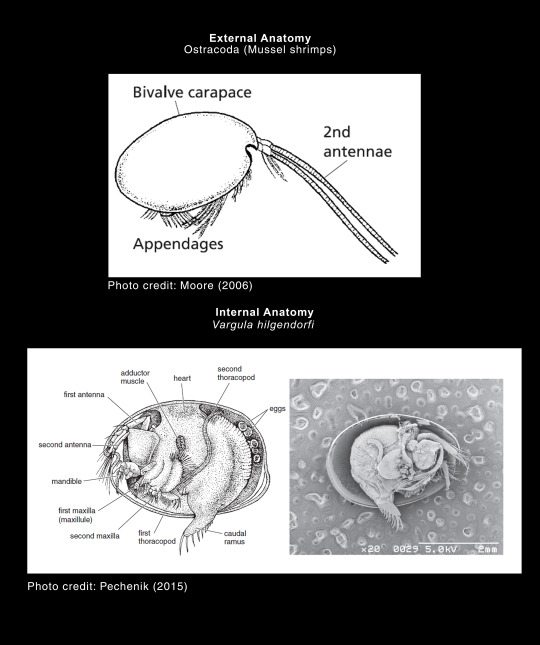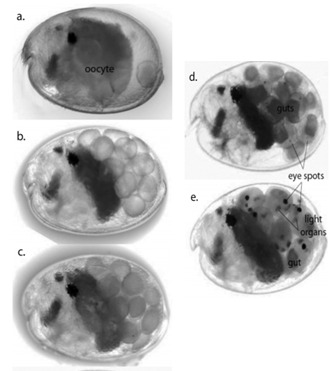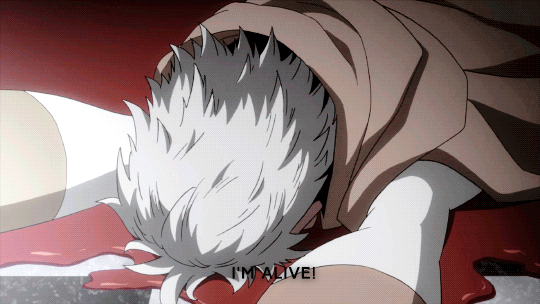#seafirefly
Explore tagged Tumblr posts
Text
ɴᴏᴡ ᴘʟᴀʏɪɴɢ: Fireflies by Owl City
───────────────⚪───────────────────
◄◄⠀▐▐ ⠀►►⠀⠀ ⠀ 1:17 / 3:48 ⠀ ───○ 🔊⠀ ᴴᴰ ⚙ ❐ ⊏⊐


Can you believe that these glowing light in the waters are sea fireflies? Everything is indeed never as it seems.
I bet you were awestruck[cod]!
Now, these millions of sea fireflies would like to wave “Hi!” as you go through the blog and get to know the bioluminescent ostracods under genus Vargula.
CLASSIFICATION
Kingdom: Animalia
Subkingdom: Bilateria
Infrakingdom: Protostomia
Superphylum: Ecdysozoa
Phylum: Arthropoda
Subphylum: Crustacea
Class: Ostracoda
Subclass: Myodocopa
Order: Myodocopida
Suborder: Myodocopina
Superfamily: Cypridinoidea
Family: Cypridinidae
Genus: Vargula
Species Name: Vargula annecohenae
(ITIS nd ; Cohen and Morin, 2010)
BIOLOGY
Cod you see me?

Ostracods can be found in basically every aquatic environment ranging from marine, freshwater, and estuarine habitats. These organisms are either swimming in the surface waters or crawling on the sea bed and moist land. Their distribution depends on their adaptations to environmental parameters, mainly salinity and water temperature. Vargula species inhabit the Pacific Ocean and Caribbean Sea coastal landmasses (Wilkinson, 1996; Ogoh & Ohmiya, 2005).
Although they are everywhere, ostracods rarely grow to a few millimeters long; small but (Pechenik, 2015). A single organism can’t be easily seen unless we look closely. Still, they’re small but widespread.
What do you mistake me as?

Ostracoda is an ancient group of crustaceans. Surprised?
The unsegmented external feature separates them from other crustaceans (Pechenik, 2015). Besides this, they resemble bivalves by having their entire body laterally enclosed inside a pair of partially calcified carapace or shells held by adductor muscles, even during early development; hence, the common name — mussel shrimp (Moore, 2006).

They are also similar to branchiopods Conchostraca (clam shrimps) such as water fleas, but the appendages, lack of growth rings, and smooth swimming of mussel shrimps gave it away. Another feature that differentiates both is the carapace formation. Clam shrimps add material to their carapace as they grow, while mussel shrimps shed their carapace with each molt (UC Museum of Paleontology, 1995).

Mussel shrimps are mostly head which means that the other body parts are greatly reduced. Their trunk is merged to the head. Usually, they have seven pairs of appendages adapted for locomotion, grasping, feeding, cleaning the carapace, or as sense organs. Vargula uses two pairs of antennae for swimming, some species only utilize one pair or the other. Notably, they have setae or tiny hairs protruding through the carapace pores that function for sensory mechanisms (Wilkinson, 1996; Pechenik, 2015).
youtube
A light show to remember
Bioluminescence is often used, but only by males of the species V. annecohenae, for mating displays. Males of each species, like fireflies on land, use distinct patterns of light flashes (seen as a series of dots) that only attract females of the same species. By performing brief dances in which they release short bursts of light as they pass towards the surface of the water, males show off just how sparkling they can be. They start their "dance," which lasts 45 minutes on average, with a stationary period in which brief (second-long or shorter) flashes of bright blue light are produced, attracting the interest of possible female mates. Then in the next process, males spiral up the water column vertically, producing quicker light bursts that are less bright (Gonzales, 2017).

(Courtesy of Gretchen Gerrish)
We compete to procreate
The male grabs onto his newfound partner with his antennae if a male is successful and an interested female arrives, and the pair will mate. Competition is intense, sometimes a woman's attention is won by the brightest male, but males can also impress by synchronizing their lighting display with other males or creeping up and taking a mate from another male (Gonzales,2017).
Life cycle
V. annecohenae has a long life cycle of up to about 1 year. It typically develops slowly for 3 months before adulthood. It has several broods of a few offspring numbering between 10-15, and has no free-living larval stage (Gerrish and Morin, 2008).
Five juvenile instars constitute the life cycle of Photeros annecohenae The life cycle of an ostracod in the genus Vargula (now Photeros) are divided by molts (that occur by the ecdysis) as well as an adult instar that is followed by a final molt (Gerrish and Morin, 2008).

The total growth period of ostracod eggs and embryos in females was 26 days, with an average of 7.84 days for the interval between mating and brood deposition, and an average of 18.4 days for the eventual release from the brood chamber. Eggs initially become evident within the female's body during development. While inside the mother's body, eggs increase in size but exhibit no other noticeable morphological changes. Females discharge fertilized embryos as translucent, spheroidal, or ovoidal masses into the marsupium or brood chamber (Gerrish and Morin, 2008).

(a) One egg of this female has been released into the marsupium and the four remaining eggs are visible in the female ovary. (b) The eggs are extruded into a marsupial brood pouch after 7-8 days. Each egg consists of a large yolk mass at this stage, and the cells inside are barely visible. C) Cell division has created a defined, cloudy cellular mass that fills the egg by day nine in the brood pouch. D) The first apparent structures include the naupliar eye, a red speck, and the intestine as the embryo develops its organs. E) The embryos appear as A-V instars with a large brown eye spot and a fully developed and functioning light organ just before release (Gerrish and Morin, 2008).
I have a sperm bank?
Female V. annecohenae can produce several broods without male re-exposure. suggesting that sperm is stored between broods (Gerrish and Morin, 2008).

I’m a natural
15-17 days after a previous cohort was released new broods can be formed (Gerrish and Morin, 2008).

ECOLOGY
youtube
Ostracods are considered to be useful paleoenvironmental indicators because their ecology is often reflected in the shape and structure of their carapaces and also considering their wide distribution in aquatic environments. They can range from warm waters of the tropics to very cold environments such as polar seas and are found from intertidal zones to many thousands of meters depth in the deep sea. They can also thrive in freshwater niches such as rivers, lakes, and even temporary ponds (Brandão & Karanovic, 2020). Generally, ostracods are characterized as omnivorous scavengers because they mainly feed on tiny organisms like algae, diatoms, bacteria, molds, and pieces of organic detritus that are present in the water or on vegetation. Some ostracods are also predatory. Being relatively smaller, they attack their prey in groups so that they can eat organisms larger than them. However, ostracods are also often preyed by small fishes (MESA, 2020).
youtube
Freshwater ostracods usually have smooth, thin, weakly calcified simple bean-shaped carapaces and feed on diatoms, bacteria, and detritus. On the other hand, pelagic ostracods may also have thin, smooth shells but they have long powerful swimming appendages or antennules. The formation of rostral incisures at the anterior of the carapace of pelagic ostracods allowed freer movement of these appendages. Furthermore, benthic ostracods are commonly detritivores or filter feeders. Their carapace is usually smooth, small, robust, and sometimes elongated because they tend to burrow into the substrate. Epifaunal ostracods have flattened ventral surfaces sometimes with projecting alar wings, frills, keels, or lateral spines while those found on coarser substrates in higher energy environments tend to have more robust heavily ribbed or reticulated carapaces (Olney, 2002).
RELATIONSHIP TO HUMANS
Generally, ostracods are useful for scientific purposes. According to Boomer et al. (2013), ostracods are being used in studies of earth science and related disciplines such as archaeology, ecology, and genetics. This is because ostracods are widely distributed and are easily preservable. Their assemblage and morphology are some of the important ecological proxies. For instance, in recent research conducted by McCormack et al. (2018) wherein ostracods are being used as a bioindicator. Their research has shown the sensitivity of ostracods’ faunal assemblage (Candona sp.) to changes in water salinity and alkalinity in Lake Van.
Next, valves of ostracods are also being used in paleoenvironmental studies. Valves of ostracods are said to absorb trace elements from host waters (Palacios-Fest et al., 1994). This characteristic makes these microcrustaceans ideal models for reconstructing and analyzing past environments that could range from deep-seas to small lakes. Aside from this, the diversity and variety of reproductive modes of ostracods are also one of the main reasons why they are being used as model organisms for laboratory and research studies (Martens & Hornes, 2009).

Moreover, laboratories have started culturing bioluminescent ostracods. The culture of these organisms is done to determine the biosynthetic pathways of bioluminescent substrates that could lead to the discovery of new tools for biotechnology and biomedicine. For instance, in the study conducted by Goodheart et al. (2019) wherein they cultured California Sea Firefly (V. tsuji) for studies regarding the biosynthetic pathway of cypridinid luciferin and genomic manipulation of an autogenic bioluminescent system.
youtube
Serve the Teaaaaa!
The T in Osctracod means Teaaaaa! 5 amazing facts you need to know about ostracods.
1. OLD BUT GOLD

Colymbosathon ecplecticos, a species of ostracod, holds the record of oldest known fossil penis. The historical penis was discovered from a 425 million-year-old rock in England. It was said that a wide variety of animals living in the sea 425 million years ago were killed by an ash fall from a volcanic eruption. However, the ash preserved the animals, including their soft parts. Through technology, the painstaking 3-D reconstructions of a preserved male ostracod revealed amazing details such as the hairs on limbs, gills, and a penis.
2. LIGHT IT UP LIKE A DYNAMITE
youtube
Some species of Myodocopida ostracods produce a bright blue light. These are known in Japan as Umi-Hotaru or sea-fireflies. The light is produced by mixing two chemicals together in the presence of oxygen and is for mating displays. Each species flash at different rates to stop any confusion in the dark. Japanese army collected Umi-Hotaru in baited traps during the Second World War. They dry them out and ground them down to a powder. Adding a small amount of water to the powder produces a low-intensity light used by soldiers to read orders or maps without giving their position away to the enemy during battles.
3. ULTIMATE SURVIVOR

Ostracods can survive being eaten by fish. Experiments with the ostracod Cypridopsis vidua showed that 26% of specimens eaten by small bluegill sunfish came out the other end alive and unharmed. This is possible because ostracods can close their shells very tightly inside their carapace to survive passage through the gut of the fish eventually to be excreted out by the fish.
4. OSTRACODS ARE OMNIPRESENT

Ostracods are found in almost every aquatic habitat, even in some very small and isolated places. They are found deep in the sea, on the shore, on wet leaf litters, springs, groundwaters, puddles, small pools, rice fields, ponds, lakes, and rivers. Some species have a global distribution and are found from the subarctic to the tropics. Their dispersal abilities caused this massive distribution of ostracods. For example, the eggs and adults can hitch a lift on the feet of birds and are displaced because of migration.
5. WE DON’T DIE, JUST DRY

The ostracod eggs can be viable many years after being dried. This is the reason why many freshwater ostracods can be found in temporary water bodies, such as puddles and rice fields. These eggs start to develop and hatch when water is already available in their environment
References
Boomer, I., et al. (2003). The Use of Ostracods in Palaeoenvironmental Studies, or What can you do with an Ostracod Shell? The Paleontological Society Papers. https://doi.org/10.1017/S1089332600002199
Brandão, S.N.; Karanovic, I. (2020). World Ostracoda Database. Accessed at http://www.marinespecies.org/ostracoda on 2020-11-15. doi:10.14284/364
Cohen, A. C.; Morin, J. G. (2010). Two New Bioluminescent Ostracode Genera, Enewton And Photeros (Myodocopida: Cypridinidae), with Three New Species from Jamaica. Journal of Crustacean Biology. 30(1): 1-55., https://doi.org/10.1651/08-3075.1
Gonzales, M.R. (2017). You Light Up My World! Smithsonian. https://ocean.si.edu/ocean-life/invertebrates/you-light-my-world
Goodheart, J., et al. (2019). Laboratory culture of the California Sea Firefly Vargula tsujii (Ostracoda: Cypridinidae): Developing a model system for the evolution of marine bioluminescence. Research Gate. https://www.researchgate.net/publication/334600678_Laboratory_culture_of_the_California_Sea_Firefly_Vargula_tsujii_Ostracoda_Cypridinidae_Developing_a_model_system_for_the_evolution_of_marine_bioluminescence
Gretchen A. Gerrish, James G. Morin, Life Cycle of a Bioluminescent Marine Ostracode, Vargula Annecohenae (Myodocopida: Cypridinidae), Journal of Crustacean Biology, Volume 28, Issue 4, 1 October 2008, Pages 669–674, https://doi.org/10.1651/07-2934.1
Horne, D. J. & Smith, R. J. (2004). First British record of Potamocypris humilis (Sars, 1924), a freshwater ostracod with a disjunct distribution in northern Europe and southern Africa. Bollettino della Societe Paleontologica Italiana, 43 (1-2), 297-306.
Laessle, A. M. 1961. A micro-limnological study of Jamaican Bromeliads. Ecology, 42, 499-517.
Martens, K., and Horne, D.J. (2009). Ostracoda. https://doi.org/10.1016/B978-012370626-3.00184-8
McCormack, J., et al. 2019. Ostracods as ecological and isotopic indicators of lake water salinity changes: the Lake Van example. Biogeosciences, 16, 2095–2114, 2019 https://doi.org/10.5194/bg-16-2095-2019
MESA. 2020. Ostracods. Marine Education Society of Australia. http://www.mesa.edu.au/crustaceans/crustaceans03.asp
Moore, J. (2006). An Introduction to the Invertebrates (2nd ed.). Cambridge University Press.
Morin, J. G. and Cohen, A. C. 1991. Bioluminescent displays, courtship, and reproduction in ostracodes. In R. Bauer and Martin, J. (Eds.), Crustacean Sexual Biology:1 16. New York:Columbia University Press.
Ogoh, K. Ohmiya, Y. (2005). Biogeography of Luminous Marine Ostracod Driven Irreversibly by the Japan Current. Molecular Biology Evolution, 22(7):1543-1545. https://doi.org/10.1093/molbev/msi155]
Olney, M. (2002). Ostracods. Microfossil image recovery and circulation for learning and education. https://www.ucl.ac.uk/GeolSci/micropal/ostracod.html
Palacios-Fest, M.R., et al. (1994). Use of ostracodes as paleoenvironmental tools in the interpretation of ancient lacustrine records. Revista Espanola de Paleontologia 9(2):145-164. https://www.researchgate.net/publication/291990499_Use_of_ostracodes_as_paleoenvironmental_tools_in_the_interpretation_of_ancient_lacustrine_records
Pechenik, J. A. (2015). Biology of Invertebrates (7th ed.). McGraw-Hill Education.
Sars, G. O. 1895. On some South-African Entomostraca raised from dried mud. Skrifter i Videnskabs-selskabet. I. Mathematisk-Naturvidenskabs Klasse 1895 (8): 1-56.
Sars, G. O. 1896. On some west Australian Entomostraca raised from dried sand. Arch. Math. Naturv. 18, 1-35.
Seidel, B. 1989. Phoresis of Cyclocypris ovum (Jurine) (Ostracoda, Podocopida, Cyprididae) on Bombina variegata (L.) (Anura, Amphibia) and Triruris vulgaris (L.) (Urodela, Amphibia). Crustaceana 57, 171-176.
Siveter, D. J., Sutton, M. D., Briggs, D. E. G. & Siveter, D. J. 2003. An ostracod crustacean with soft parts from the Lower Silurian. Science, 302, 1749 - 1751.
UC Museum of Paleontology. (1995). Introduction to the Ostracoda. https://ucmp.berkeley.edu/arthropoda/crustacea/maxillopoda/ostracoda.html
13 notes
·
View notes
Photo

They're not the fire flies I'm used to but 😍 #SomewhereInJapan #SetoSea #SeaFireflies #Amazing #Beautiful #WoW #Places https://www.instagram.com/p/CFpS-N1HHwc/?igshid=1im0huw2g7rep
0 notes
Video
うみほたる 英語で #seafirefly っていうらしい 各ホテルや旅館でプランあるから鳥羽に来たら見に来て! 芭新萃(はなしんすい)、サン浦島、TAOYA志摩 、石鏡第一ホテル神倶良、リゾートヒルズ豊浜、浜の雅亭一井 #芭新萃 #はなしんすい #サン浦島悠季の里 #TAOYA志摩 #石鏡第一ホテル神倶良 #リゾートヒルズ豊浜 #浜の雅亭一井 #うみほたる #ウミホタル #観光 #伊勢志摩 https://www.instagram.com/p/B0hrFdsn2sV/?igshid=iq9x5bo9oj9s
0 notes
Photo

#seafireflies #bioluminescent #japan #nature #incredible #stunningshots #ilovenature
0 notes
Photo

海ほたる - Umihotaru by hidesax on Flickr.
#”海ほたる”#umihotaru#seafirefly#expressway#light#stream#trails#street#lamp#tokyobay#skyline#hidesax#nikon#d800e#nikkor80400mmf4556g
2 notes
·
View notes